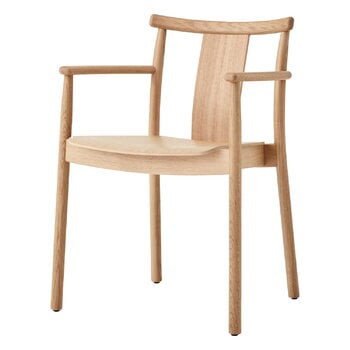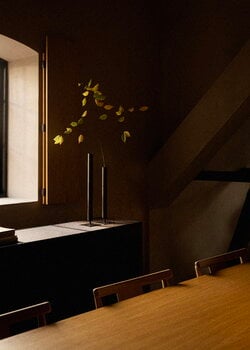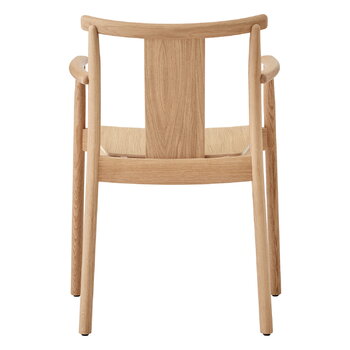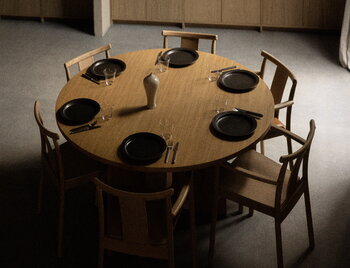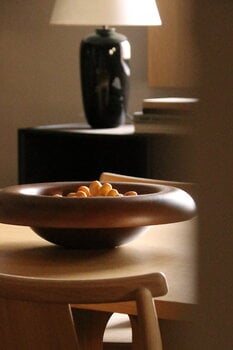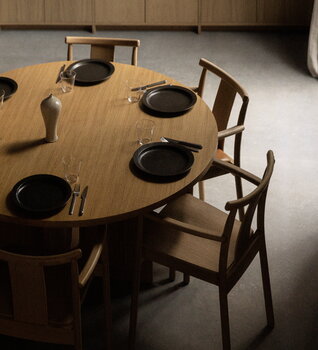Audo Copenhagen's Merkur dining armchair was originally designed for the Oslo Stock Exchange, one of Norway's most famous buildings. A hint at this is in fact given already by the chair's name which refers to Mercurius, the god of financial gain and commerce in Roman mythology. The design studio Skogstad & Wærnes wanted to create a chair that would honour the centuries-long history of the prestigious building, but also make an impact outside it. The Merkur dining chair's soft lines, timeless design and elegant look of oak with its exposed wood grain patterns make the chair a perfect companion for home kitchens and offices, as well as restaurants, meeting rooms and lobbies.
Merkur dining chair with armrest, oak
Audo Copenhagen
Description
Audo Copenhagen's Merkur dining armchair was originally designed for the Oslo Stock Exchange, one of Norway's most famous buildings. A hint at this is in fact given already by the chair's name which refers to Mercurius, the god of financial gain and commerce in Roman mythology. The design studio Skogstad & Wærnes wanted to create a chair that would honour the centuries-long history of the prestigious building, but also make an impact outside it. The Merkur dining chair's soft lines, timeless design and elegant look of oak with its exposed wood grain patterns make the chair a perfect companion for home kitchens and offices, as well as restaurants, meeting rooms and lobbies.
Product details (11)
- Colour
- Lacquered oak, gloss 8
- Width
- 46 cm
- Depth
- 52 cm
- Height
- 78 cm
- Seat depth
- 42 cm
- Seat height
- 46 cm
- Armrest height
- 66 cm
- Material
- Solid oak, plywood
- Weight
- 5.3 kg
- Stackable
- No
- Care instructions
- Dust or wipe clean with a damp cloth. Dry well.
- Product ID
Designer
Skogstad & Wærnes is an Oslo-based design studio, founded by designers Petter Skogstad (b. 1985) and Fredrik Wærnes (b. 1985). The duo met each other while studying at Oslo Metropolitan University and ECAL, and founded their own studio in 2020. Skogstad & Wærnes design a wide range of products, from furniture to lighting, and their work is characterized by a focus on innovative design. One of their most famous work is the Merkur chair which was designed together with MENU for Oslo's monumental Stock Exchange building.
View all productsReviews (0)
Sustainability
The Product Sustainability Framework, our criteria of sustainable design, helps you find the most sustainable products in our selection. Read below which sustainability criteria this product has met.
Working conditions & labour 7/9
-
Equal opportunities for all employees
-
Commitment to UN Global Compact, fair compensation for all employees
-
Corporate responsibility requirements defined and communicated for suppliers
-
Systematic work for improved inclusion and well-being in the workplace
-
Transparent supply chain
-
Suppliers' compliance to a code of conduct ensured
-
Compliance to the UN Guiding Principles on Business and Human Rights ensured in the supply chain
-
Direct suppliers audited and certified
-
Support for community involvement in the supply chain
Eco-friendly production 8/9
-
Fair and resource-wise water-use in production
-
No incineration or landfilling of returned items
-
No use of endangered species as materials
-
No direct environmental emissions or waste (excl. GHGs) from production
-
The sustainability of direct suppliers' production is addressed and monitored
-
Production and material sourcing that respect biodiversity, animal rights, and natural ecosystems
-
Material-efficient and ecological packaging
-
No potentially harmful chemicals used in own production
-
Positive impact on nature’s well-being through operations that regenerate natural ecosystems
Climate impact 4/8
-
Company's direct greenhouse gas emissions identified and commitment to reduction
-
Product's carbon impact identified and commitment to reduction
-
Guidance on energy- and eco-efficient use of the product
-
Carbon footprint of the product calculated and goals set to reduce it
-
Contribution to climate initiatives beyond the brand’s direct operations
-
Low-carbon or compensated transportation
-
100 % renewable energy in own production and operations
-
Carbon neutral or carbon negative product
Sustainable materials 6/6
-
Sustainable and long-lasting material choices
-
No harmful or hazardous substances
-
Responsible raw material sourcing and production
-
Materials suited for circularity: monomaterials, recyclable finishings, renewable or recycled contents etc.
-
Ecological materials: natural, biodegradable, recyclable or recycled contents
-
Outstanding materials in terms of innovativeness, responsibility, sustainability and circularity: local production or sourcing, 100 % recycled content, C2C-certification etc.
Circular design 4/5
-
High aesthetic quality promoting long-term use of the product
-
Technically durable product design and material choices
-
Design for enduring life-long quality
-
Design and support for product maintenance, repair and upgradability
-
Innovative circular design solutions: circular service system, resale platform, remanufacturing, collection of used products, etc.
